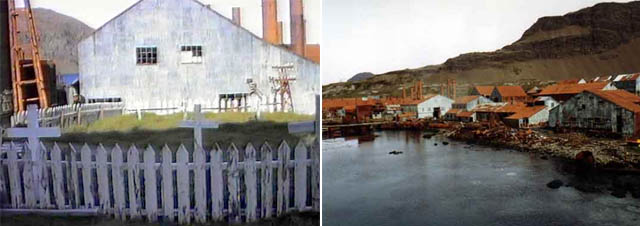While the South Pole and environs doesn’t have a permanent population, there are on average 2,500 people living there during the year -- approximately 4000 in summer and 1000 incredibly hardy ones in winter. While no complete necrologies exists for the Antarctic, at least 268 people have died there since humanity first decided it was a good place to visit. The most famous and disturbingly well-preserved of these places is the camp built by Robert Scott and his party on Ross Island in 1911. The seaweed-insulated wooden cabin and its outbuildings were supposed to be the team’s shelter when they returned from their attempt to be the first people to visit the South Pole. Scott and four others -- Edward Wilson, H. R. Bowers, Laurence Oates and Edgar Evans -- set out from the base to reach the pole. They reached it on Jan. 17, 1912 only to find that the Norwegian explorer Roald Amundsen had gotten there weeks before them. All five men died trying to get back to the base camp. The final three – Scott, Wilson and Bowers – were just 11 miles from it when they died. Today this hut can easily be visited as it close to both the US Base at McMurdo or New Zealand's Scott Base. Be warned though, global warming is beginning to take its toll and the 100-year-old seal blubber which had been in deep freeze has begun to smell “quite rancid.” Here is the Evans Hut; on the right is the seal blubber... Deception Island is a deceptive place indeed! and a Deception hangar - In 1906 a Norwegian-Chilean whaling company started using Whalers Bay as a base for a factory ship. Other whaling operations followed suit and a boom town was born. Whalers Bay was abandoned in 1931 following a precipitous decline in the market for whale oil, a result of the Great Depression. Do not be deceived, however. The rest of Deception Island is actually a fairly hopping place. In addition to science bases operated by Spain and Argentina, it is also one of the more popular tourist destinations in the Antarctic. This is probably because (thanks to volcanic activity) the island actually has places where one can be warm. South Georgia is another Antarctic island that people rushed to abandon. At least seven whaling communities existed there during the first half of the 20th century. When all were up and running the island was estimated to have 2,000 people living on it. Most of the towns are in the process of returning to a state of wilderness but some buildings – notably in the town of Grytviken – have been kept up and are also becoming a tourist destination. Stromness Harbour boilers and power generators: Portuguese graveyard, and a huge Leith Harbour whaling ghost station: Grytviken ships "Dias" and "Albatros": The whaler's cinema... and some old harpoon guns. It is worth noting that these frozen islands have been the subject of heated arguments over who actually owns them – mostly by the UK and Argentina. Deception was initially claimed by the UK and then apparently ceded to the Argentines. South Georgia and the South Shetland islands are still possessed by the UK. The dispute over ownership of South Georgia was a contributing factor in The Falklands War (described by Argentine writer Jorge Louis Borges as “two bald men fighting over a comb”) and was briefly occupied by the Argentines. It is possible wars have been fought over more useless pieces of real estate but none come to mind. Slicing through the silence... The Real "Mountains of Madness" Some meteorites arrive from Mars, some come from further reaches of space... |
Thursday, December 11, 2008
Frozen Ghosts
Dark Roasted Blend revisits the cold, frozen barrens of the South Pole and finds ghosts.
Subscribe to:
Post Comments (Atom)






















No comments:
Post a Comment